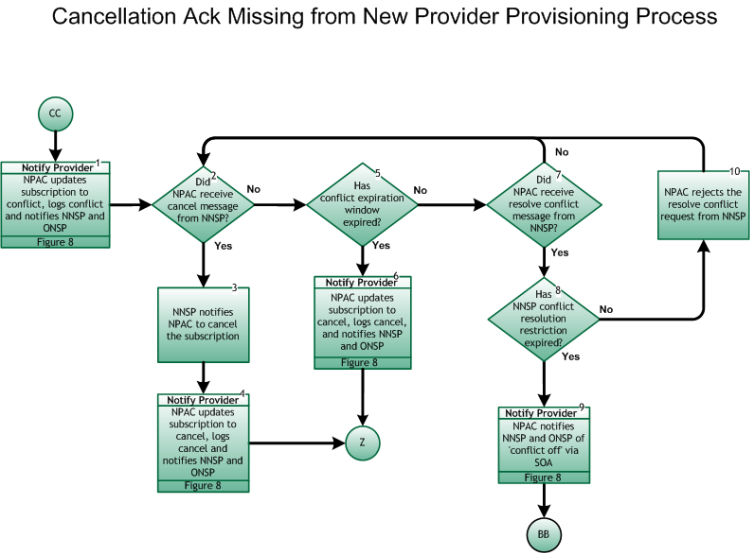- Port Type Determination Process
- Wireless ICP Process
- Broadband Verification Process
- Wireline Simple Port LSR/FOC Process
- Wireline Non-Simple Port LSR/FOC Process
- Main Porting Process
- Subscription Version Create Process
- Reseller/Interconnected VoIP Provider/Type 1 Notification Process
- Provisioning Without Unconditional 10-Digit Trigger Process
- Provisioning With Unconditional 10-Digit Trigger Process
- Conflict Flow for the Service Creation Provisioning Process
- Cancellation Flow for Provisioning Process
- Cancellation Ack Missing from New Provider Provisioning Process
- Disconnect Process for Ported TN
- Audit Process
- Code Opening Process
- First TN Ported In NPA-NXX Process
- Cancel-Undo Process

Please note, the Cancellation Conflict Process is reached only for "concurred" subscriptions.
Step 1: Notify Provider – NPAC updates subscription to conflict, logs conflict, and notifies NNSP and ONSP
- This is the entry point from the Inter-Service Provider LNP Operations Flows – Cancellation Flow For Provisioning Process, tie point CC, Figure 12 .
- If the NNSP does not provide a cancellation notification message to NPAC, in spite of a Cancellation LSR from the ONSP and a reminder message from NPAC, the subscription is placed in a conflict state. NPAC also writes the proper conflict cause code to the subscription record, and notifies both SPs, with proper conflict cause code, of the change in status via the SOA interface.
- For the notification process, refer to Inter-Service Provider LNP Operations Flows – Reseller/Interconnected VoIP Provider/Type 1 Notification, Figure 8.
- Both SPs take appropriate action related to internal work orders.
Step 2: Did NPAC receive cancel message from NNSP?
- Only “missing cancellation ACK from New SP” subscriptions reach this point in the process flow. The subscription will transition to pending or cancel.
- With the subscription in conflict , it is only the NNSP who controls the transaction. The NNSP makes a concerted effort to contact the ONSP prior to proceeding.
- If Yes, go to Step 3.
- If No, go to Step 5.
Step 3: NNSP notifies NPAC to cancel subscription
- The NNSP may decide to cancel the subscription. If so, they notify NPAC of this decision via the SOA interface.
Step 4: Notify Provider – NPAC updates subscription to cancel, logs cancel, and notifies NNSP and ONSP
- Following notification by the NNSP to cancel the subscription, NPAC logs this information, and changes the subscription status to canceled . Both SPs are notified of the change in the subscription status via the SOA interface.
- For the Notification process, refer to Inter-Service Provider LNP Operations Flows – Reseller/Interconnected VoIP Provider/Type 1 Notification, Figure 8.
- Both SPs take appropriate action related to internal work orders.
- Return to Main Porting Flow, tie point Z, Figure 6.
Step 5: Has conflict expiration window expired?
- At this point in the process flow, the subscription status is conflict , and is awaiting conflict resolution or the expiration of the tunable window (Conflict Expiration Window, current value of 30 days).
- If Yes, go to Step 6.
- If No, go to Step 7.
Step 6: Notify Provider – NPAC updates subscription to cancel, logs cancel, and notifies NNSP and ONSP
- After no response from the NNSP for 30 calendar days regarding this particular subscription, NPAC changes the status to canceled and notifies both SPs of the change in status via the SOA interface.
- For the notification process, refer to Inter-Service Provider LNP Operations Flows – – Reseller/Interconnected VoIP Provider/Type 1 Notification, Figure 8.
- Both SPs take appropriate action related to internal work orders.
- Return to Main Porting Flow, tie point Z, Figure 6.
Step 7: Did NPAC receive resolve conflict message from NNSP
- The NNSP may choose to proceed with the porting process, in spite of a cancellation message from the ONSP. As both SPs are presumably basing their actions on the End User’s request, and each is apparently getting a different request from that End User, each should ensure the accuracy of the request.
- If the NNSP decides to proceed with the porting, they send a resolved conflict message via the SOA interface.
- It is the responsibility of the NNSP to contact the ONSP, to request that related work orders which support the porting process are performed. The ONSP must support the porting process.
- If Yes, go to Step 8.
- If No, return to Step 2.
Step 8: Has NNSP conflict resolution restriction expired?
- At this point in the process flow, the subscription status is conflict , and is awaiting conflict resolution or the expiration of the tunable window (current values of six hours for wireline-involved Non-Simple Ports [Long Conflict Resolution New Service Provider Restriction], two hours for wireline-involved Simple Ports [Medium Conflict Resolution New Service Provider Restriction], and six hours for wireless [Short Conflict Resolution New Service Provider Restriction]).
- The conflict resolution restriction window is only applicable the first time a subscription is placed into conflict, whether the conflict is invoked by the NPAC due to this process, or placed into conflict by the ONSP.
- If Yes, go to Step 9.
- If No, go to Step 10.
Step 9: Notify Provider – NPAC notifies NNSP and ONSP of ‘conflict off’ via SOA
- For the Notification process, refer to Inter-Service Provider LNP Operations Flows – Reseller/Interconnected VoIP Provider/Type 1 Notification , Figure 8.
- NPAC notifies both SPs of the change in subscription status. The porting process resumes as normal, at tie-point BB, Figure 6.
Step 10: NPAC rejects the resolve conflict request from NNSP
- The NNSP has sent the resolve conflict message before the expiration of the conflict resolution restriction window. NPAC returns an error message back via the SOA interface.
- Return to Step 2.
